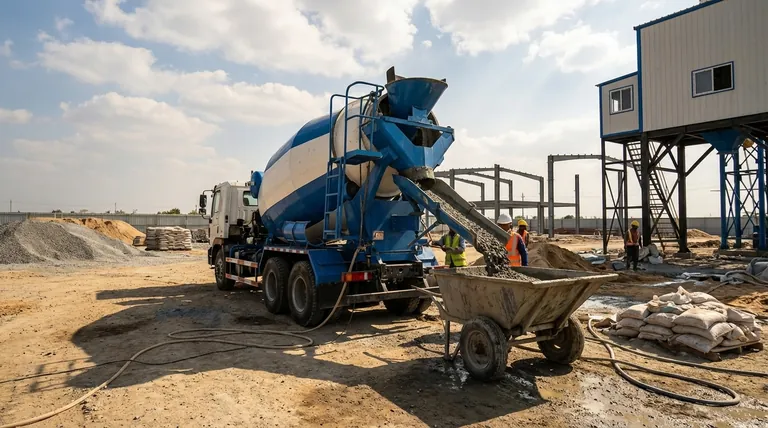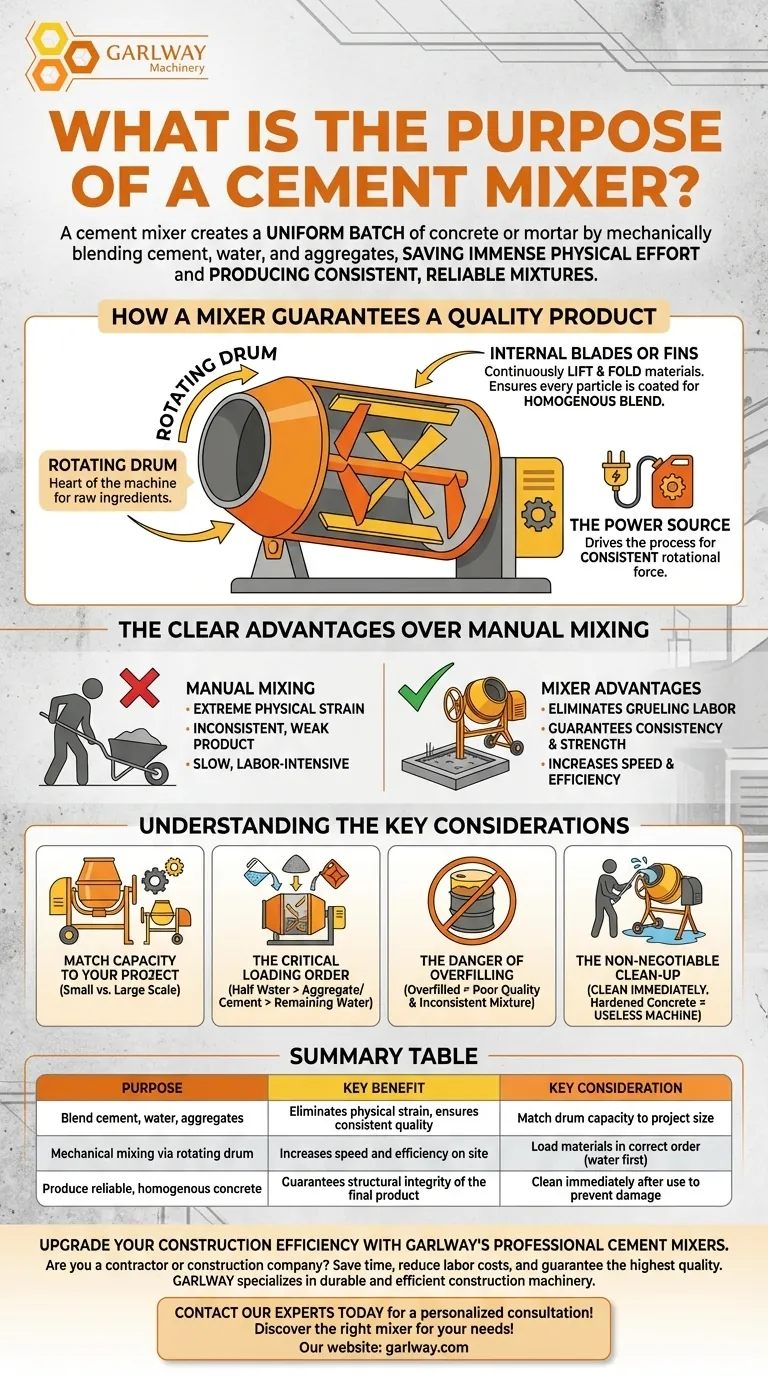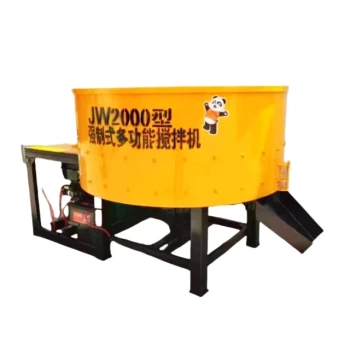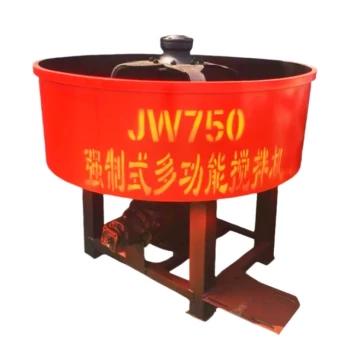A cement mixer's fundamental purpose is to create a uniform batch of concrete or mortar by mechanically blending cement, water, and aggregates like sand or gravel. This automation saves immense physical effort and produces a far more consistent and reliable mixture than is possible by hand.
The core problem with mixing concrete manually is the intense physical labor and the high risk of an inconsistent, weak product. A cement mixer solves this by using a rotating drum to do the heavy lifting, guaranteeing a thoroughly and evenly blended mixture every time.

How a Mixer Guarantees a Quality Product
A cement mixer might seem simple, but its design is engineered for one specific outcome: perfect consistency. This is achieved through the interplay of its key components and the mechanical action they produce.
The Rotating Drum
The heart of the machine is a large, rotating cylindrical drum. This is where the raw ingredients are loaded.
Internal Blades or Fins
Inside the drum are fixed blades or fins. As the drum turns, these blades continuously lift the materials up and let them tumble back down into the rest of the mixture.
This constant lifting and folding action is what ensures every particle of sand and gravel gets coated with the cement paste, creating a homogenous blend.
The Power Source
This entire process is driven by a motor, which can be electric for smaller DIY projects or a more powerful gasoline engine for larger, remote job sites. The motor provides the consistent rotational force needed for thorough mixing.
The Clear Advantages Over Manual Mixing
Choosing to use a mixer over a shovel and wheelbarrow is about more than just convenience; it's about improving the quality of your work and protecting your body.
Eliminating Extreme Physical Strain
The most immediate benefit is the elimination of grueling manual labor. Mixing concrete by hand puts enormous strain on the back, shoulders, and muscles. A mixer handles this entire workload.
Ensuring Consistency and Strength
A mixer's mechanical process removes human error and fatigue from the equation. This guarantees a uniform consistency from one batch to the next, which is critical for the structural integrity and strength of the cured concrete.
Increasing Speed and Efficiency
A machine can prepare a batch of concrete significantly faster than a person can by hand. This allows you to lay more concrete in less time, keeping your project on schedule.
Understanding the Key Considerations
While a mixer is a powerful tool, its effectiveness depends on proper selection and use. Missteps can lead to poor results or damage to the machine.
Match Capacity to Your Project
Mixers come in various sizes. A small, portable mixer is ideal for residential jobs like setting fence posts, while large-scale construction requires a much larger capacity to be efficient.
The Critical Loading Order
For the best results, materials should be loaded in the correct order. The standard practice is to add about half the water first, followed by the aggregate and cement, and then the remaining water as needed.
The Danger of Overfilling
Never fill the drum to the brim. The materials need empty space to tumble and fold properly. An overfilled mixer cannot blend the ingredients effectively, resulting in a poor-quality, inconsistent mixture.
The Non-Negotiable Clean-Up
You must clean the mixer immediately after you finish your last batch. Any concrete left inside will harden, unbalancing the drum and eventually rendering the machine useless.
Making the Right Choice for Your Goal
Selecting and using a mixer effectively comes down to understanding the demands of your specific project.
- If your primary focus is small DIY projects: A standard electric-powered, vertical-axis mixer is typically the most convenient and effective choice for home patios, walkways, or post holes.
- If your primary focus is efficiency on a larger job: A gas-powered mixer with a larger drum capacity will provide the power and volume needed to avoid delays and keep the work moving forward.
- If your primary focus is achieving the strongest possible concrete: Always prioritize correct loading procedures and monitor the mixing time to achieve a perfectly uniform consistency in every batch.
Ultimately, a cement mixer is a tool that transforms a labor-intensive chore into a predictable and efficient process, ensuring the strength and integrity of your work.
Summary Table:
| Purpose | Key Benefit | Key Consideration |
|---|---|---|
| Blend cement, water, aggregates | Eliminates physical strain, ensures consistent quality | Match drum capacity to project size |
| Mechanical mixing via rotating drum | Increases speed and efficiency on site | Load materials in correct order (water first) |
| Produce reliable, homogenous concrete | Guarantees structural integrity of the final product | Clean immediately after use to prevent damage |
Upgrade your construction efficiency with GARLWAY's professional cement mixers.
Are you a contractor or construction company looking to save time, reduce labor costs, and guarantee the highest quality concrete for your projects? GARLWAY specializes in durable and efficient construction machinery, including concrete mixers, winches, and batching plants designed for reliability on any job site.
Let us help you build stronger, faster, and smarter. Contact our experts today for a personalized consultation and discover the right mixer for your needs!
Visual Guide

Related Products
- HZS75 Concrete Batching Plant Cement Mixer Price Concrete Mixer Bunnings Mixing Plant
- JZC1000 Industrial Concrete Mixer Machine Cement Mixer Price
- Auto Concrete Cement Mixer Machine New
- Concrete Cement Mixer Machine Drum Mixer for Construction
- JDC350 Small Cement Concrete Mortar Mixer
People Also Ask
- Can you mix self leveling concrete in a cement mixer? Avoid Costly Flooring Mistakes
- How to start a concrete plant business? A Step-by-Step Guide to Launching Your Venture
- What can you mix in a cement mixer? Unlock Its Full Potential for Concrete & Beyond
- How does ready-mix work? A Guide to Efficient, High-Quality Concrete Delivery
- What are the disadvantages of ready mixed concrete? Navigate Logistical & Cost Risks



















